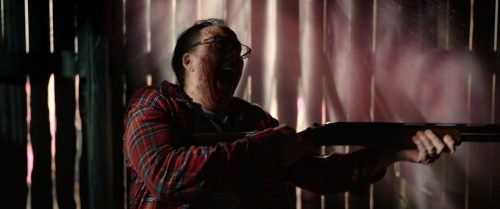MOVIE REVIEW
Color Out of Space (2020)
If you’re going to return to making feature films after 27 years away, you might as well pick up where you left off. The opening credits of “Color Out of Space” have Lavinia (Madeleine Arthur) carrying out a Wicca ritual, appealing to the angels to take care of her mother, and the words "Directed by Richard Stanley" appear over a close-up of the antique compass in her hand. Back in 1992 Mr. Stanley’s previous feature, "Dust Devil," started with another pilgrim looking at a hand-held totem; but then the figure was a supernatural serial killer and the item was a pocket watch going backwards. And back before that, the credits of “Hardware” ended with a post-apocalyptic scavenger dressed in the very 1990 boho-gothic style of Carl McCoy from the band Fields of the Nephilim (for it was he) holding another battered compass in equal close-up, although the credits on-screen at that exact instant are the freighted names of Bob and Harvey Weinstein. Three films, three nomads, looking at three antique analogue icons for some signal from a cosmos that shows every sign of being otherwise engaged.
Characters in H. P. Lovecraft stories lose their bearings when faced with the cruelty of the universe and the author’s brain-meltingly terrible creatures, although his short story “The Color Out of Space” adds a particular problem for filmmakers: The rendering of a color specifically described as indescribable. Analogue technology being perhaps no help, Mr. Stanley’s adaptation opts for maximal digital blast. The film swims in a seething froth of hues from the ultraviolet end of the spectrum, representing the malevolence which arrives one night via meteorite into the lives of Nathan Gardner (Nicolas Cage) and his family in the woods of Arkham. Aggressive use of color is still an aspect of cinema hardly ever explored outside the abstract sector, and the effect here is bracingly energetic; but not all that unexpected, given the way Mr. Stanley color-coded the visuals of both “Hardware” and “Dust Devil.”
Both those films were social commentaries and backhanded black comedies, and "Color" fits the pattern. Lovecraft, not one for families or jokes, would have appreciated how Nathan’s witticisms fall flat before his family is blasted to atoms. The Gardner clan has gone back to the land as a reaction against modern life, and the film dabbles with their opposition to a destructive infrastructure project. Nathan even rears alpacas, although possibly only for the sight of Mr. Cage being Mr. Cage while milking one. (The actor is on more restrained form, or possibly just better directed, than in the unspeakable “Mandy,” a film carrying the strong scent of Cthulhu by-product.) But good intentions count for nothing in a Lovecraft universe. Theresa Gardner (Joely Richardson) even attempts to carry on a modern job in the finance industry from her desk in the backwoods, and duly suffers the most body-warping horrors of all. Compared to these nouveau-drop-outs, their crusty old neighbor Ezra is played straight (but by Tommy Chong so not that straight) as an authentic counter-cultural relic, right down to the fact that he can keep his technology working – a nod from Mr. Stanley to the way that the original nerds and original hippies overlapped as seekers. But it does Ezra no good either, once the pineal eyes start opening.
Mr. Stanley throws in a bunch of his own internal compass points, marking his territory. During the wilderness years he made "The Secret Glory," a documentary about the occult fixations of SS Obersturmführer Otto Rahn which at one point ponders whether the Holy Grail was a meteorite itself. In "Color" he also returns an old favor, wrangling onto a TV screen none other than Marlon Brando, star of Mr. Stanley’s cursed attempt to film “The Island of Dr. Moreau”; plus it’s the Brando of "One Eyed Jacks" at that, one harried and put-upon director belatedly signaling to another. And even though Lovecraft’s infamous racism may have eased in his final years, "Color"'s creation of a young black man as its narrator seems a pointed statement from Mr. Stanley, whose “Dust Devil” was entirely about the fever of apartheid South Africa and the damage racism might leave behind. But “Color” plays a broader allegorical hand, a more mainstream fantasy film by a mile, and the purple tendrils polluting the earth and the water could stand in for multiple man-made calamities. “We all know it’s coming,” intones a Color-infused Mr. Chong. “But we can't get away.” He could have a number of different “Its” on his mind; but Mr. Stanley seems to have the happy labors of filmmaking back on his, another nomad apparently emerging from a lost corner of the universe back into the light.

Comments